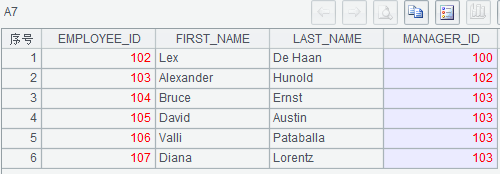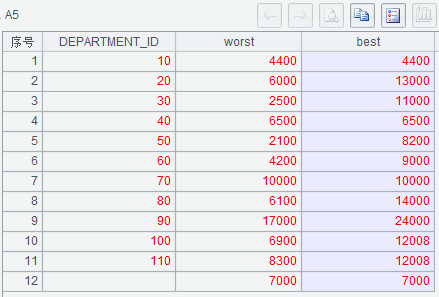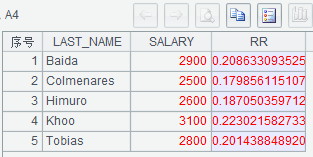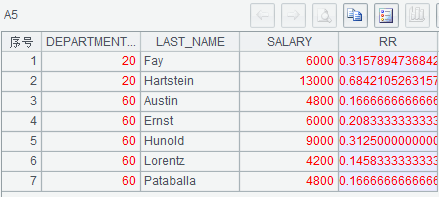如何協助 MySQL 實現 Oracle 高階分析函式
Oracle 支援一些獨特的語法和函式,在移植到 MySQL 上時或多或少給程式設計師造成了困擾,下面我們針對 Oracle 的一些特殊用法舉例並講解如何用集算器來完成同樣功能。這些方法當然也不限於針對 MySQL,對於所有其它資料庫也能支援。
1、 遞迴語句
a) select employee_id,first_name,last_name,manager_id
from hr.employees
start with employee_id=102
connect by prior employee_id = manager_id
A |
|
1 |
=connect("orcl") |
2 |
[email protected]("select employee_id, first_name, last_name, manager_id from hr.employees") |
3 |
=A2.keys(EMPLOYEE_ID) |
4 |
|
5 |
=A2.switch(MANAGER_ID, A2) |
6 |
=A2.nodes(MANAGER_ID, A4) |
7 |
=(A4|A6).new(EMPLOYEE_ID, FIRST_NAME, LAST_NAME, MANAGER_ID.EMPLOYEE_ID:MANAGER_ID) |
(1) A3 設定序表 A2 的鍵
(2) A4 選取起始僱員
(3) A5 將 A2 中 MANAGER_ID 值轉換成記錄,以便遞迴
(4) A6 獲取起始僱員的所有子節點

b) select employee_id, first_name,last_name,manager_id
from hr.employees
start with employee_id=104
connect by prior manager_id = employee_id
A |
|
1 |
=connect("orcl") |
2 |
[email protected]("select employee_id, first_name, last_name, manager_id from hr.employees") |
3 |
=A2.keys(EMPLOYEE_ID) |
4 |
=A2.switch(MANAGER_ID, A2) |
5 |
[email protected](EMPLOYEE_ID==104) |
6 |
=A5.prior(MANAGER_ID) |
7 |
=A6.new(EMPLOYEE_ID, FIRST_NAME, LAST_NAME, MANAGER_ID.EMPLOYEE_ID:MANAGER_ID) |
(1) A6 獲取起始僱員的所有父節點

c) select employee_id,last_name,manager_id,sys_connect_by_path(last_name,'/') path from hr.employees
start with employee_id=102
connect by prior employee_id = manager_id
A |
|
1 |
=connect("orcl") |
2 |
[email protected]("select employee_id, last_name, manager_id,null path from hr.employees") |
3 |
=A2.keys(EMPLOYEE_ID) |
4 |
[email protected](EMPLOYEE_ID==102) |
5 |
=A2.switch(MANAGER_ID, A2) |
6 |
=A2.nodes(MANAGER_ID, A4) |
7 |
=A4|A6 |
8 |
=A7.run(PATH=if(EMPLOYEE_ID==102, "/"+LAST_NAME, MANAGER_ID.PATH+"/"+LAST_NAME)) |
9 |
=A7.new(EMPLOYEE_ID, LAST_NAME, MANAGER_ID.EMPLOYEE_ID:MANAGER_ID, PATH) |
(1) 由於 A7 中每條記錄的父節點都在本節點之前,故 A8 可以從前往後對 A7 中每條記錄依次修改 PATH 值

2、 巢狀聚集函式
select avg(max(salary)) avg_max, avg(min(salary)) avg_min
from hr.employees
group by department_id
A |
|
1 |
=connect("orcl") |
2 |
[email protected]("select * from hr.employees") |
3 |
=A2.groups(DEPARTMENT_ID;max(SALARY):m1, min(SALARY):m2) |
4 |
=A3.group(;~.avg(m1):avg_max,~.avg(m2):avg_min) |
(1) A2 中 A1.query 也可以改用 A1.cursor

3、 聚集分析函式 FIRST 和 LAST
SELECT department_id,
MIN(salary) KEEP (DENSE_RANK FIRST ORDER BY commission_pct) worst,
MAX(salary) KEEP (DENSE_RANK LAST ORDER BY commission_pct) best
FROM hr.employees
GROUP BY department_id
ORDER BY department_id
A |
|
1 |
=connect("orcl") |
2 |
[email protected]("select * from hr.employees order by department_id,commission_pct") |
3 |
[email protected](DEPARTMENT_ID) |
4 |
=A3.new(DEPARTMENT_ID,[email protected](ifn(COMMISSION_PCT,2)).min(SALARY):worst, [email protected](ifn(COMMISSION_PCT,2)).max(SALARY):best) |
5 |
=A4.sort(ifn(DEPARTMENT_ID,power(2,32))) |
(1) A2 已按 DEPARTMENT_ID 排序,則 A3 分組時可採用 [email protected]
(2) FIRST/LAST 取排序的後第一組 / 最後一組,而 Oracle 排序時 null 排在最後,所以 LAST 會取到的最後一組就是 null 值所在組。maxp/minp 求具有最大值 / 最小值的所有行時排除了 null,所以在 A4 是用 ifn(COMMISSION_PCT,2) 保證 null 值時最大
(3) A5 中,DEPARTMENT_ID=null 時採用採用比所有 DEPARTMENT_ID 都大的 power(2,32) 來保證這一行排在最後
如果資料量大,還可以採用遊標方式。
A |
|
1 |
=connect("orcl") |
2 |
[email protected]("select * from hr.employees") |
3 |
=A2.groups(DEPARTMENT_ID; min([if(COMMISSION_PCT,2),SALARY]):m1, max([if(COMMISSION_PCT,2), SALARY]):m2) |
4 |
=A3.new(DEPARTMENT_ID, m1(2):worst, m2(2):best) |
5 |
=A4.sort(ifn(DEPARTMENT_ID,power(2,32))) |
(1) A3 中,min([if(COMMISSION_PCT,2), SALARY]) 求出 COMMISSION_PCT 最小時的 SALARY 最小值,即 COMMISSION_PCT 排名第一時 SALARY 最小值,max 類似

4、 佔比函式 ratio_to_report
a) SELECT last_name, salary, RATIO_TO_REPORT(salary) OVER () AS rr
FROM hr.employees
WHERE job_id = 'PU_CLERK'
ORDER BY last_name
A |
|
1 |
=connect("orcl") |
2 |
[email protected]("select last_name,salary from hr.employees where job_id='PU_CLERK'order by last_name") |
3 |
=A2.sum(SALARY) |
4 |
=A2.new(LAST_NAME, SALARY, SALARY/A3:RR) |

b) SELECT department_id,last_name, salary, RATIO_TO_REPORT(salary) OVER (partition by department_id) AS rr
FROM hr.employees
WHERE department_id in (20,60)
ORDER BY department_id,last_name
A |
|
1 |
=connect("orcl") |
2 |
[email protected]("select department_id,last_name,salary from hr.employees where department_id in (20,60) order by department_id,last_name") |
3 |
[email protected](DEPARTMENT_ID;sum(SALARY):sum) |
4 |
=A2.switch(DEPARTMENT_ID, A3) |
5 |
=A2.new(DEPARTMENT_ID.DEPARTMENT_ID:DEPARTMENT_ID, LAST_NAME, SALARY, SALARY/DEPARTMENT_ID.sum:RR) |
(1) A2 中已按 DEPARTMENT_ID 排序,則 A3 可用 [email protected] 分組聚集

5、 多重分組
SELECT department_id, job_id, sum(salary) total
FROM hr.employees
WHERE department_id in (30, 50)
GROUP BY grouping sets((department_id, job_id), department_id)
A |
|
1 |
=connect("orcl") |
2 |
[email protected]("select department_id, job_id, salary from hr.employees where department_Id in (30,50) order by department_id, job_id") |
3 |
[email protected](DEPARTMENT_ID, JOB_ID; sum(SALARY):TOTAL) |
4 |
[email protected](DEPARTMENT_ID, null:JOB_ID; ~.sum(TOTAL):TOTAL) |
5 |
=[A3,A4].merge(DEPARTMENT_ID, ifn(JOB_ID,fill("z", 10))) |
(1) 因為 A3 和 A4 均對 DEPARTMENT_ID 有序,故 A5 可 merge,ifn(JOB_ID,fill("z",10))) 用來保證 JOB_ID 為 null 排在後面
也可以採用遊標方式。
A |
|
1 |
=connect("orcl") |
2 |
[email protected]("select department_id,job_id,sum(salary) total from hr.employees where department_id in (30,50) group by department_id, job_id order by department_id,job_id") |
3 |
=A2.group(DEPARTMENT_ID) |
4 |
=A3.(~.insert(0, [email protected](DEPARTMENT_ID, null:JOB_ID;sum(TOTAL):TOTAL))) |
5 |
=A4.fetch() |
6 |
=A5.conj() |
(1) A3 中 A2.group 要求 A2 對 DEPARTMENT_ID 有序
(2) A4 對 A3 每一組求和並將結果插入此組末尾
還可以採用管道方式。
A |
|
1 |
=connect("orcl") |
2 |
[email protected]("select department_id, job_id, salary from hr.employees where department_Id in (30,50) order by department_id, job_id") |
3 |
=channel()[email protected](DEPARTMENT_ID, JOB_ID; sum(SALARY):TOTAL) |
4 |
>A2.push(A3) |
5 |
=channel()[email protected](DEPARTMENT_ID, null:JOB_ID; sum(TOTAL):TOTAL) |
6 |
>A3.push(A5) |
7 |
=A3.fetch() |
8 |
for A2,1000 |
9 |
=A3.result()|A5.result() |
10 |
=A9.sort(DEPARTMENT_ID) |
(1) A3 建立管道,並附加分組求和
(2) A4 將 A2 中資料推送到 A3,注意此動作只有在 A2 中資料有實際取出行為才執行
(3) A5 建立管道,並附加分組求和
(4) A6 將 A3 結果推送到 A5,此處也可以直接將 A2 中資料推送到 A5,但會增加時間複雜度
(5) A7 保留 A3 的資料
(6) 迴圈讀取 A2,每次只取 1000 條,減少記憶體佔用
(7) A10 對 A3 和 A5 中資料排序,因為演算法是穩定的,所以 JOB_ID 為 null 的排在後面

